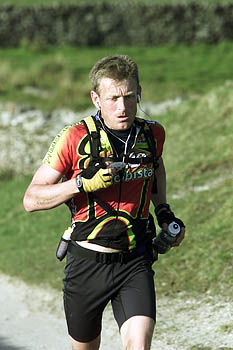 More than 200 runners and walkers will this weekend tackle the gruelling challenge that is the Fellsman Hike.
More than 200 runners and walkers will this weekend tackle the gruelling challenge that is the Fellsman Hike.
The route takes competitors over 62 miles of Yorkshire Dales terrain and involves 11,000 feet of ascent. This year’s Hike will be the 45th.
Left: Fellsman title holder Mark Hartell
©Tom Smith
Mark Hartell has dominated the event in recent years, completing the course in not much more than 10 hours, and he’s back again to defend his title. If the Macclesfield Harrier wins the 2007 race, he’ll have won more Fellsman Hikes than anyone else.
Last year’s winning time was slow by Hartell’s measure, with the course covered in 11 hours 37 mins, compared with his 2005 best of 10 hours 15 mins. Record time for the arduous route, across fells, moorland and bog, is 10 hours 11mins.
The Fellsman Hike has grown from small beginnings in 1962, when only 57 runners and walkers started and a mere 15 finished the course. Last year 224 left the start at Ingleton, with 53 retiring before the finish at Threshfield in Wharfedale.
The course crosses some of the hardest terrain in the Dales, beginning with an ascent of Ingleborough followed by Whernside, Gragareth, Great Coum, Great Knoutberry, Dodd Fell, Middle Tongue, Buckden Pike and Great Whernside. All but the fastest runners have to contend with navigating part of the course during night, including the glutinous bogs of Fleet Moss, often encountered around midnight.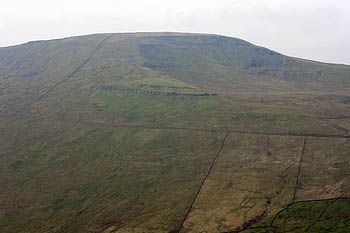
There’s no sleep for competitors, the last of whom drag their aching bodies to Upper Wharfedale School 28 hours after the start. Conditions at the moment are relatively dry underfoot, but more rain is forecast for the week ahead, continuing into the weekend.
Running the event is a massive task, with more than 250 volunteer helpers manning headquarters, checkpoints, picking up retired hikers and providing safety cover and food for competitors. Seven minibuses are en route at any time and there are more than 40 radio operators including one at each of the 26 checkpoints. Many of the bases are on the fell tops, only accessible on foot, and all the equipment has to be carried up there.
There are even temporary stiles to be erected for the many sections that don’t follow footpaths and then there’s the catering. At least 350 people are catered for, with food provided evolving as the event becomes more and more dominated by faster runners who want high-energy food easily digested.
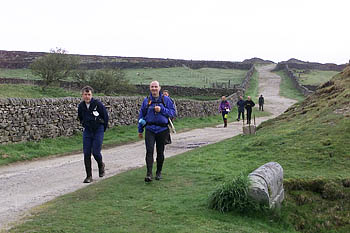 Suzanne Carter, headquarters controller for the event, which is run by Keighley Scouts Service Team, said: “We’ve tried to listen to what competitors want as food. We’ve got flapjacks and the sausage rolls at Dent have gone! Ten tons of stodge is no longer there.”
Suzanne Carter, headquarters controller for the event, which is run by Keighley Scouts Service Team, said: “We’ve tried to listen to what competitors want as food. We’ve got flapjacks and the sausage rolls at Dent have gone! Ten tons of stodge is no longer there.”
Left: Fellsman competitors approach Yarnbury checkpoint
©Tom Smith
Pasta and sauce, bananas, malt loaf, rice pudding and fruit have replaced some of the more traditional pies and standard Scout dishes that were previously on offer.
There will be a new fastest woman: last year’s women’s winner Sarah Rowell won’t be taking part. Mark Hartell will no doubt be hoping he can snatch the men’s record, depending on course conditions. He’s a master of the Bob Graham Round, which involves summiting 42 Lakeland Peaks over a distance of 74 miles in under 24 hours. He’s pushed this to 77 peaks, still in less than 24 hours, so distance and hillrunning are second nature to him.
The Fellsman Hike is now starting to attract increasing numbers of entrants again after falling away from its peak of 450 starters in the mid 1970s. It’s now a leg of the Montrail Ultra Running Championships, which has helped boost numbers.
Suzanne Carter told grough: “The Long Distance Walkers Association (LDWA) 100 encroached on our territory but from an entrant’s point of view, it’s not possible to do both.
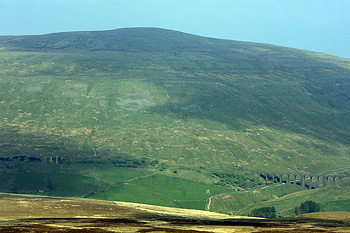 “You can’t do 60-odd miles then 100km two weeks after, so what a lot of people are doing is alternating: they’ll do LDWA one year, Fellsman next. But the numbers are going up. The Montrail series for us has been quite a bonus. It’s mutually beneficial, because they wanted a long-distance event and we get more publicity, so that seems to be bringing in a lot of novices which is great.
“You can’t do 60-odd miles then 100km two weeks after, so what a lot of people are doing is alternating: they’ll do LDWA one year, Fellsman next. But the numbers are going up. The Montrail series for us has been quite a bonus. It’s mutually beneficial, because they wanted a long-distance event and we get more publicity, so that seems to be bringing in a lot of novices which is great.
Left: Great Knoutberry
“The numbers are picking up this year. They were slightly up last year and they look to be up again this year, so if we get the same number of people entering on the day as usual, which is about 30, we’re hoping to get about 280 entrants this year.
Hikers set off from Ingleborough Community Centre at Ingleton at 9am on Saturday, 12 May and will arrive at the finish any time from 7pm onwards, with walkers still reaching the end after noon on Sunday. You can watch the event and encourage the walkers and runners from any of the fell-top checkpoints as well as roadside venues such as the Hill Inn, Chapel-le-Dale, Kingsdale, near Yordas Cave, Dent, at the Conder Farm campsite, Stonehouse at Dent Head, Fleet Moss, Cray and Park Rash above Kettlewell. Be warned, however, that if you give any sort of assistance to the hikers, they’ll be disqualified, so no snaffling them jelly babies!
Safety is an obvious concern for organisers, with so many hikers out on the fells over such a wide area. Competitors are compulsorily grouped during darkness hours and there’s a big team keeping track of them.
Suzanne Carter said: “There are three sweep teams. They call in at a checkpoint, wait for the safety-check team to arrive there, clear all the paperwork and then they set off from there.
“There’s a radio at every checkpoint, including the hilltop checkpoints. There are 42 sets in use.
“Everything is recorded on sheets. There are five copies, each of which goes to a different place. There’s also a master check card. Each checkpoint officer has one of those.
“There are two control centres at Threshfield and Cam Fell. Cam is basically the radio relay point and Threshfield is headquarters, so we deal with all the paperwork and Cam relay it and collect it. Cam usually shuts down about 6am on Sunday because everyone is that side of the event.
“Upper Wharfedale Fell Rescue is on standby for us, the local police are on standby, St John Ambulance are on standby, so they know that it’s happening.
“We have a doctor who’s mobile. He has a radio and is in frequent contact. He combs the checkpoints and goes wherever he’s needed.
“We also then have a first aider at Threshfield who, for the past two years has been a fully trained staff nurse. We have other nurses as well and this year we are hoping to have a fully trained anaesthetist! Not that we’re hoping to use him. He’s the husband of the nurse and they have transport so they can go out as well.”
Weather can have a major effect on participants. High levels of drop-outs are usually down to bad conditions on the fells and it’s not unknown for there to be snow during the event.
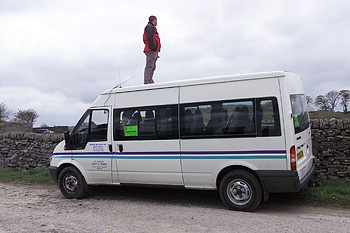 Serious incidents have been thankfully rare. One competitor died in a road accident while driving home. Organisers recommend no-one drives themselves after 62 miles on their feet.
Serious incidents have been thankfully rare. One competitor died in a road accident while driving home. Organisers recommend no-one drives themselves after 62 miles on their feet.
Suzanne recounts the physical effects on one competitor: “She walked all the way in backwards from Yarnbury to Threshfield [the final two miles] because she couldn’t walk forwards any longer.
“She had two poles and she came in walking backwards. She lost seven toenails and she went home in the back of a Fiesta with both legs straight, one on the driver’s side, one on the passenger side because she couldn’t bend her knees any more.”
There are two new trophies this year: the Great Knoutberry Trophy, donated by veterans Terry Butterworth and Andrew Joynson, will be awarded to the first finisher over the age of 60, which will ‘recognise the achievements of those entrants who, at an age when most people are collecting their bus pass, are competing on one of the toughest cross-country challenges in the UK’.
The second new trophy is named after Mike Wooding, who died while caving last year. Mike successfully completed several Fellsman Hikes and was entrant number one in 2006. His friends have donated the trophy in his memory.
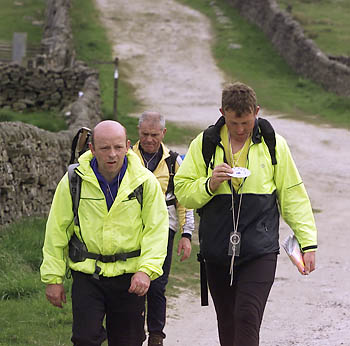 The event’s administrator Juliette Moor said: “Some friends of his wanted to sponsor an award in his name and we decided to have a nominated trophy for the Fellsman spirit. It will be decided by the Fellsman committee based on recommendations by hikers and staff.
The event’s administrator Juliette Moor said: “Some friends of his wanted to sponsor an award in his name and we decided to have a nominated trophy for the Fellsman spirit. It will be decided by the Fellsman committee based on recommendations by hikers and staff.
“All entrants have got forms and they will be available at the start and at Threshfield and possibly at checkpoints. We want it to be a success so please return a nomination form.”
Left: Fellsman Hikers approach a checkpoint
Spare a thought for some of the volunteers manning the checkpoints for up to 22 hours as well as the super fit runners and walkers who complete the event or even make it part way round the course, which requires drawing on all an individual’s mental depths as well as physical strength and stamina. If you should see someone on Monday with a strange gait, bleeding feet and matchsticks holding open their eyes, you can guess they’re a Fellsman.
Final word on the event is Suzanne Carter’s: “The weekend itself is great – completely knackering whether you’re walking it or not!”
Montrail Ultra Running Championship
Guest
11 May 2007Just a minor correction concerning the "LDWA 100" - it is not, as Suzanne Carter said, 100km - it is [b]100 miles[/b] and both have been done in the same year but not by people looking for a fast time on either.
escorts shanghai
20 February 2013This is a very good thing, is your best choice, this is a good thing.